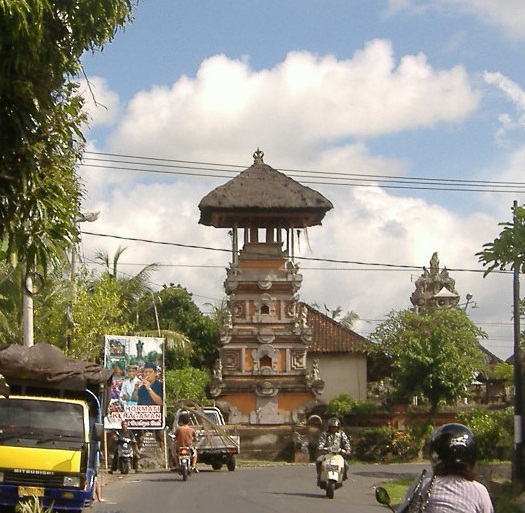|
Anggabaya
Anggabaya is a small village in Bali, Indonesia. Title Its correct formal title is Desa Pekraman Anggabaya (in the Balinese language) or Desa Adat Anggabaya (in the Indonesian language). In English it would be The Traditional (or Customary) Village of Anggabaya. Desa = Village. NB. Pekraman is also spelt Pakraman - both spellings are equally to be found in use. In common parlance it is usually referred to as Banjar Anggabaya (a Banjar is more or less the same as a Parish), or just simply Anggabaya. Location It is located approximately 4½ miles north of the centre of Denpasar, the provincial capital of Bali, and is situated on Jalan Trenggana (Trenggana Road). The nearest villages are Pelagan to the south, Jenah to the south-west, Cengkilung to the north-west and Jabajero to the east. A small river, known locally as Tukad Anggabaya, flows down from the north through the eastern part of the village, separating the hamlet of Jungut from the rest of the village. The Village In ... [...More Info...] [...Related Items...] OR: [Wikipedia] [Google] [Baidu] |
Anggabaya Temple Tower
Anggabaya is a small village in Bali, Indonesia. Title Its correct formal title is Desa Pekraman Anggabaya (in the Balinese language) or Desa Adat Anggabaya (in the Indonesian language). In English it would be The Traditional (or Customary) Village of Anggabaya. Desa = Village. NB. Pekraman is also spelt Pakraman - both spellings are equally to be found in use. In common parlance it is usually referred to as Banjar Anggabaya (a Banjar is more or less the same as a Parish), or just simply Anggabaya. Location It is located approximately 4½ miles north of the centre of Denpasar, the provincial capital of Bali, and is situated on Jalan Trenggana (Trenggana Road). The nearest villages are Pelagan to the south, Jenah to the south-west, Cengkilung to the north-west and Jabajero to the east. A small river, known locally as Tukad Anggabaya, flows down from the north through the eastern part of the village, separating the hamlet of Jungut from the rest of the village. The Village In ... [...More Info...] [...Related Items...] OR: [Wikipedia] [Google] [Baidu] |
Subak (irrigation)
Subak is the water management (irrigation) system for the paddy fields on Bali island, Indonesia. It was developed in the 9th century. For the Balinese, irrigation is not simply providing water for the plant's roots, but water is used to construct a complex, pulsed artificial ecosystem. The system consists of five terraced rice fields and water temples covering nearly . The temples are the main focus of this cooperative water management, known as ''subak''. Religious relationship Subak is a traditional ecologically sustainable irrigation system that binds Balinese agrarian society together within the village's Bale Banjar community center and Balinese temples. The water management is under the authority of the priests in water temples, who practice Tri Hita Karana Philosophy, a self-described relationship between humans, the earth and the gods. Tri Hita Karana draws together the realm of spirit, the human world and nature. The overall subak system exemplifies this philosophi ... [...More Info...] [...Related Items...] OR: [Wikipedia] [Google] [Baidu] |
Indonesian Language
Indonesian ( ) is the official language, official and national language of Indonesia. It is a standard language, standardized variety (linguistics), variety of Malay language, Malay, an Austronesian languages, Austronesian language that has been used as a lingua franca in the multilingual Indonesian archipelago for centuries. Indonesia is the fourth most list of countries by population, populous nation in the world, with over 270 million inhabitants—of which the majority speak Indonesian, which makes it one of the most List of languages by total number of speakers, widely spoken languages in the world.James Neil Sneddon. ''The Indonesian Language: Its History and Role in Modern Society''. UNSW Press, 2004. Most Indonesians, aside from speaking the national language, are fluent in at least one of the more than 700 indigenous languages of Indonesia, local languages; examples include Javanese language, Javanese and Sundanese language, Sundanese, which are commonly used at home a ... [...More Info...] [...Related Items...] OR: [Wikipedia] [Google] [Baidu] |


